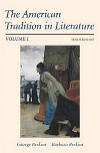 |  The American Tradition in Literature, Volume 1, 10/e George Perkins,
Eastern Michigan University
Barbara Perkins,
University of Toledo-Toledo
Key ConceptsSelections in the readings address human nature in conflict and related moral and ethical motifs. In the conventions of the Puritan lexicon, he explores the origins of evil and the character of sin as arrogance, hypocrisy, and undue pride. Character conflicts in all his stories are framed in ironies that defy simplistic, one or two-dimensional interpretations. Like Melville, Hawthorne employs the allegory, one of the oldest narrative patterns in Western literature, in which symbols elevate his characters and their dilemmas to universal significance. As a participant in the discourse of his day on letters and literary criticism, Hawthorne defines his works within the circle of conventions characteristic of "romances" rather than "novels," claiming for himself as a writer, as he did in his "Preface to The House of the Seven Gables, a certain "latitude" beyond the limitations of the more realistic novel. Such an attitude allowed him to introduce within the familiar course of human events a "slight evanescent" flavor of the Gothic and the supernatural. |
|



 2003 McGraw-Hill Higher Education
2003 McGraw-Hill Higher Education